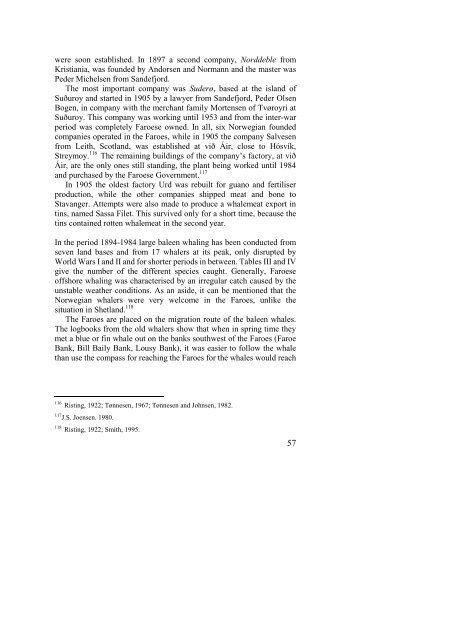The North Atlantic Fisheries, 1100-1976 - University of Hull
The North Atlantic Fisheries, 1100-1976 - University of Hull
The North Atlantic Fisheries, 1100-1976 - University of Hull
You also want an ePaper? Increase the reach of your titles
YUMPU automatically turns print PDFs into web optimized ePapers that Google loves.
were soon established. In 1897 a second company, Norddeble from<br />
Kristiania, was founded by Andorsen and Normann and the master was<br />
Peder Michelsen from Sandefjord.<br />
<strong>The</strong> most important company was Suderø, based at the island <strong>of</strong><br />
Suðuroy and started in 1905 by a lawyer from Sandefjord, Peder Olsen<br />
Bogen, in company with the merchant family Mortensen <strong>of</strong> Tvøroyri at<br />
Suðuroy. This company was working until 1953 and from the inter-war<br />
period was completely Faroese owned. In all, six Norwegian founded<br />
companies operated in the Faroes, while in 1905 the company Salvesen<br />
from Leith, Scotland, was established at við Áir, close to Hósvík,<br />
Streymoy. 116 <strong>The</strong> remaining buildings <strong>of</strong> the company’s factory, at við<br />
Áir, are the only ones still standing, the plant being worked until 1984<br />
and purchased by the Faroese Government. 117<br />
In 1905 the oldest factory Urd was rebuilt for guano and fertiliser<br />
production, while the other companies shipped meat and bone to<br />
Stavanger. Attempts were also made to produce a whalemeat export in<br />
tins, named Sassa Filet. This survived only for a short time, because the<br />
tins contained rotten whalemeat in the second year.<br />
In the period 1894-1984 large baleen whaling has been conducted from<br />
seven land bases and from 17 whalers at its peak, only disrupted by<br />
World Wars I and II and for shorter periods in between. Tables III and IV<br />
give the number <strong>of</strong> the different species caught. Generally, Faroese<br />
<strong>of</strong>fshore whaling was characterised by an irregular catch caused by the<br />
unstable weather conditions. As an aside, it can be mentioned that the<br />
Norwegian whalers were very welcome in the Faroes, unlike the<br />
situation in Shetland. 118<br />
<strong>The</strong> Faroes are placed on the migration route <strong>of</strong> the baleen whales.<br />
<strong>The</strong> logbooks from the old whalers show that when in spring time they<br />
met a blue or fin whale out on the banks southwest <strong>of</strong> the Faroes (Faroe<br />
Bank, Bill Baily Bank, Lousy Bank), it was easier to follow the whale<br />
than use the compass for reaching the Faroes for the whales would reach<br />
116 Risting, 1922; Tønnesen, 1967; Tønnesen and Johnsen, 1982.<br />
117 J.S. Joensen. 1980.<br />
118 Risting, 1922; Smith, 1995.<br />
57















